

Bruce Lee Biography. 5 Asian American Inventions You Didn’t Know Were Asian American Inventions. I’m sure most of our savvy readers know that the fortune cookie is an Asian American invention, not an Asian one.
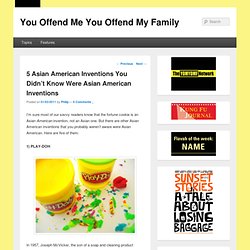
But there are other Asian American inventions that you probably weren’t aware were Asian American. Here are five of them: In 1957, Joseph McVicker, the son of a soap and cleaning product manufacturer, decided to help his sister-in-law (a nursery school teacher) find an alternative to the conventional clay which was too hard for her young students to play with.
Enter Dr. Tin Liu, a self-described Chinese American “Confucian philosopher and practical scientist,” who was hired by McVicker to come up with a solution. Two Korean immigrants, Kim Hyung-soon and Kim Ho, made their way to California via the Hawaiian plantations in 1913 with one goal: “To become the first millionaires in the Korean (American) community.” Anyone who uses computers (i.e. everyone reading this), has most likely also used the Universal Serial Bus technology a.k.a. the USB. Angel Island, Chinese-American Immigration History (tour, poems, photos, timeline, history) In the 19th century, the United States began experiencing its first substantial waves of immigrants.
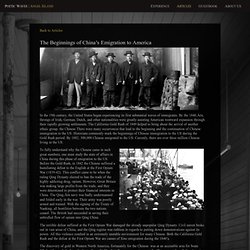
By the 1840’s, throngs of Irish, German, Dutch, and other nationalities were greatly assisting American westward expansion through their rapidly growing settlements. The California Gold Rush of 1849 helped to bring about the arrival of another ethnic group, the Chinese There were many occurrences that lead to the beginning and the continuation of Chinese immigration to the US. Historians commonly mark the beginnings of Chinese immigration to the US during the Gold Rush period. Museum of Chinese in America (MOCA) Museum of Chinese in America (MOCA) Angel Island, Chinese-American Immigration History (tour, poems, photos, timeline, history) The picturesque Angel Island, located in the San Francisco Bay is known for being a favored travel destination that is perfect for a family vacation.
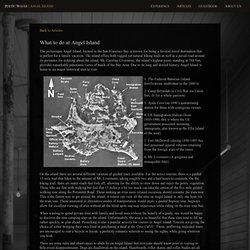
The island offers both rugged yet natural hiking trails as well as a paved road around its perimeter for trekking about the island. Mt. Caroline Livermore, the island’s highest point, standing at 788 feet, provides remarkable panoramic views of much of the Bay Area. Due to its long and storied history, Angel Island is home to six major historical sites to visit: On the island there are several different varieties of guided tours available. When wanting to spend private time with family and loved ones without the benefit of a guide, one would be happy to discover the nine camping sites on the island.
There are some rules and observances to abide by on Angel Island that everyone should know prior to visiting to help avoid disappointments. Angel Island : Poetic Waves, Chinese Immigration History (tour, poems, photos, timeline, history) Gallery4. Mrs.
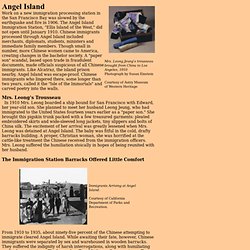
Leong's Trousseau In 1910 Mrs. Leong boarded a ship bound for San Francisco with Edward, her year-old son. She planned to meet her husband Leong Jeung, who had immigrated to the United States fourteen years earlier as a "paper son. " She brought this pigskin trunk packed with a few treasured garments: pleated embroidered skirts and wide-sleeved long jackets, tiny slippers and bolts of China silk. The excitement of her arrival was greatly lessened when Mrs. The Immigration Station Barracks Offered Little Comfort From 1910 to 1935, about ninety-five percent of the Chinese attempting to immigrate cleared Angel Island. Paper Sons Tried to Outsmart the Exclusion Laws The destruction of vital statistics enabled some Chinese immigrants to enter the United States through deceit and bribery. Immigrants still faced tough questions as interrogators relentlessly tried to bar common laborers from entering the country. Los Angeles Attorney, Y.
Immigration to the US, Immigration, Railroads, and the West. Cover, California.
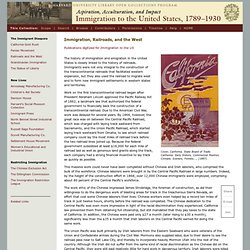
State Board of Trade. California: Early History, Commercial Position, Climate, Scenery, Forests..., [1897]. The history of immigration and emigration in the United States is closely linked to the history of railroads. Immigrants were not only integral to the construction of the transcontinental railroads that facilitated western expansion, but they also used the railroad to migrate west and to form new immigrant settlements in western states and territories. Work on the first transcontinental railroad began after President Abraham Lincoln approved the Pacific Railway Act of 1862, a landmark law that authorized the federal government to financially back the construction of a transcontinental railroad. This massive work could never have been completed without Chinese and Irish laborers, who comprised the bulk of the workforce. Between 1865 and 1869, the Central Pacific had laid 690 miles of track and the Union Pacific 1,087 miles of track. Gallery1. Immigration to the US, California Gold Rush, 1848-1858.
Charles Drayton Gibbes, A New Map of the Gold Region in California, 1851, Harvard Map Collection.
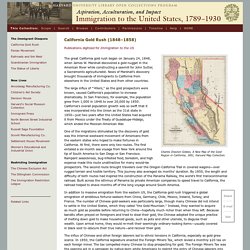
The great California gold rush began on January 24, 1848, when James W. Marshall discovered a gold nugget in the American River while constructing a sawmill for John Sutter, a Sacramento agriculturalist. News of Marshall’s discovery brought thousands of immigrants to California from elsewhere in the United States and from other countries.